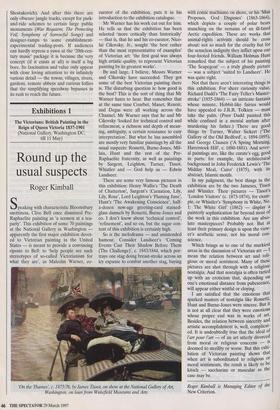Exhibitions 1
Round up the usual suspects
Roger Kimball Speaking with characteristic Bloomsbury snottiness, Clive Bell once dismissed Pre- Raphaelite painting as 'a sermon at a tea- party'. This exhibition of some 70 paintings at the National Gallery in Washington — apparently the first major exhibition devot- ed to Victorian painting in the United States — is meant to provide a convincing riposte to Bell: to 'help people see such stereotypes of so-called Victorianism for what they are', as Malcolm Warner, co- curator of the exhibition, puts it in his introduction to the exhibition catalogue.
Mr Warner has his work cut out for him. He tells us that the exhibition has been selected 'more critically than historically' — that is, that he and his co-curator, Nico- lai Cikovsky, Jr., sought 'the best rather than the most representative of examples' of Victorian art: 'the first goal was always high artistic quality, to represent Victorian painting by its greatest works'.
By and large, I believe, Messrs Warner and Cikovsky have succeeded. They got some of the best Victorian painting there is. The disturbing question is: how good is the best? This is the sort of thing that Mr Warner hates to hear. But remember that at the same time Courbet, Manet, Renoir, and Degas were all working across the Channel. Mr Warner says that he and Mr Cikovsky 'looked for technical control and refinement, a richness and depth of mean- ing, ambiguity, a certain resistance to easy interpretation'. But what he has assembled are mostly very familiar paintings by all the usual suspects: Rossetti, Bume-Jones, Mil- lais, Hunt and the rest of the Pre- Raphaelite fraternity, as well as paintings by Sargent, Leighton, Turner, Tissot, Whistler and — God help us — Edwin Landseer.
There are some very famous pictures in this exhibition: Henry Wallis's 'The Death of Chatterton', Sargent's ',Carnation, Lily, Lily, Rose', Lord Leighton's 'Flaming June', Hunt's 'The Awakening Conscience', half- a-dozen new-age greeting-card stained- glass damsels by Rossetti, Burne-Jones and co. I don't know about 'technical control', 'refinement', and so on, but the sugar con- tent of this exhibition is certainly high.
So is the melodrama — and unintended humour. Consider Landseer's 'Coming Events Cast Their Shadow Before Them (The Challenge)', c. 1843/1844, which por- trays one stag doing breast-stroke across an icy expanse to combat another stag, baying 'On the Thames', c. 1875176, by James Tissot, on show at the National Gallery of Art, Washington, on loan from Wakefield Museums and Arts with comic machismo on shore, or his 'Man Proposes, God Disposes' (1863-1864), which depicts a couple of polar bears munching on the remains of an ill-fated Arctic expedition. These are works that animal-rights activists should be cross about: not so much for the cruelty but for the senseless indignity they inflict upon our four-footed friends. William Holman Hunt remarked that the subject of his painting 'The Scapegoat' — a truly ghastly picture — was a subject 'suited to Landseer'. He was quite right.
Not that there aren't interesting things in this exhibition. For sheer curiosity value, Richard Dadd's 'The Fairy Teller's Master- stroke' (1855-1864) — an intricate fantasia whose minute, Hobbit-like fairies would have appealed to J.R.R. Tolkien — must take the palm. (Poor Dadd painted this while confined in a mental asylum after murdering his father.) There are good things by Turner, Walter Sickert ('The Gallery of the Old Bedford', c. 1894-1895), and George Clausen CA Spring Morning, Haverstock c. 1880-1881). And sever- al paintings are, like the curate's egg, good in parts: for example, the architectural background in John Frederick Lewis's 'The Midday Meal, Cairo' (1875), with its abstract, Islamic motifs.
In my judgment, the best things in the exhibition are by the two Jameses, Tissot and Whistler. Their pictures — Tissot's 'London Visitors' (c. 1873-1874), for exam- ple, or Whistler's 'Symphony in White, No. 1: The White Girl' (1862) — display a painterly sophistication far beyond most of the work in this exhibition. Are any abso- lute masterpieces? Probably not. But at least their primary design is upon the view- er's aesthetic sense, not his moral con- science.
Which brings us to one of the murkiest areas in the discussion of Victorian art —.I mean the relation between art and reli- gious or moral sentiment. Many of these pictures are shot through with a religiose nostalgia. And that nostalgia is often tarted up with an eroticism that, depending on one's emotional distance from pubescence, will appear either wistful or cloying. I am satisfied that the emotions that sparked masters of nostalgia like Rossetti, Hunt and Bume-Jones were sincere. But it is not at all clear that they were emotions whose proper end was in works of art. Besides, the relation between sincerity and artistic accomplishment is, well, complicat- ed. It is undoubtedly true that the ideal of l'art pour l'art — of an art utterly divorced from moral or religious concerns — doomed to sterility or worse. But this exhi- bition of Victorian painting shows that when art is subordinated to religious or moral sentiments, the result is likely to be kitsch — saccharine or muscular as the case may be.
Roger Kimball is Managing Editor of the New Criterion.


































































 Previous page
Previous page